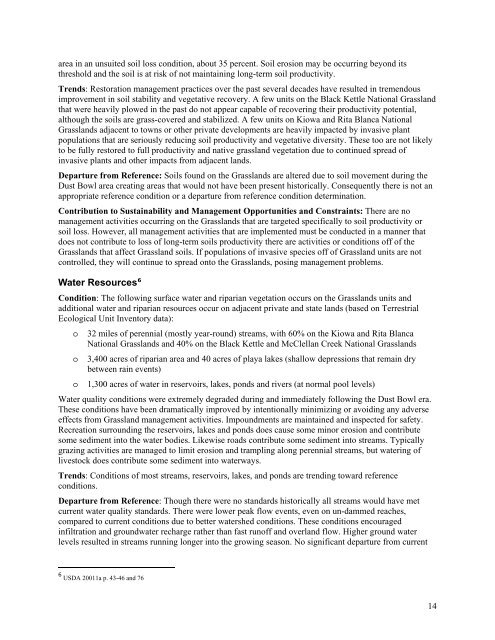Comprehensive Evaluation Report
Comprehensive Evaluation Report
Comprehensive Evaluation Report
Create successful ePaper yourself
Turn your PDF publications into a flip-book with our unique Google optimized e-Paper software.
area in an unsuited soil loss condition, about 35 percent. Soil erosion may be occurring beyond its<br />
threshold and the soil is at risk of not maintaining long-term soil productivity.<br />
Trends: Restoration management practices over the past several decades have resulted in tremendous<br />
improvement in soil stability and vegetative recovery. A few units on the Black Kettle National Grassland<br />
that were heavily plowed in the past do not appear capable of recovering their productivity potential,<br />
although the soils are grass-covered and stabilized. A few units on Kiowa and Rita Blanca National<br />
Grasslands adjacent to towns or other private developments are heavily impacted by invasive plant<br />
populations that are seriously reducing soil productivity and vegetative diversity. These too are not likely<br />
to be fully restored to full productivity and native grassland vegetation due to continued spread of<br />
invasive plants and other impacts from adjacent lands.<br />
Departure from Reference: Soils found on the Grasslands are altered due to soil movement during the<br />
Dust Bowl area creating areas that would not have been present historically. Consequently there is not an<br />
appropriate reference condition or a departure from reference condition determination.<br />
Contribution to Sustainability and Management Opportunities and Constraints: There are no<br />
management activities occurring on the Grasslands that are targeted specifically to soil productivity or<br />
soil loss. However, all management activities that are implemented must be conducted in a manner that<br />
does not contribute to loss of long-term soils productivity there are activities or conditions off of the<br />
Grasslands that affect Grassland soils. If populations of invasive species off of Grassland units are not<br />
controlled, they will continue to spread onto the Grasslands, posing management problems.<br />
Water Resources 6<br />
Condition: The following surface water and riparian vegetation occurs on the Grasslands units and<br />
additional water and riparian resources occur on adjacent private and state lands (based on Terrestrial<br />
Ecological Unit Inventory data):<br />
o 32 miles of perennial (mostly year-round) streams, with 60% on the Kiowa and Rita Blanca<br />
National Grasslands and 40% on the Black Kettle and McClellan Creek National Grasslands<br />
o 3,400 acres of riparian area and 40 acres of playa lakes (shallow depressions that remain dry<br />
between rain events)<br />
o 1,300 acres of water in reservoirs, lakes, ponds and rivers (at normal pool levels)<br />
Water quality conditions were extremely degraded during and immediately following the Dust Bowl era.<br />
These conditions have been dramatically improved by intentionally minimizing or avoiding any adverse<br />
effects from Grassland management activities. Impoundments are maintained and inspected for safety.<br />
Recreation surrounding the reservoirs, lakes and ponds does cause some minor erosion and contribute<br />
some sediment into the water bodies. Likewise roads contribute some sediment into streams. Typically<br />
grazing activities are managed to limit erosion and trampling along perennial streams, but watering of<br />
livestock does contribute some sediment into waterways.<br />
Trends: Conditions of most streams, reservoirs, lakes, and ponds are trending toward reference<br />
conditions.<br />
Departure from Reference: Though there were no standards historically all streams would have met<br />
current water quality standards. There were lower peak flow events, even on un-dammed reaches,<br />
compared to current conditions due to better watershed conditions. These conditions encouraged<br />
infiltration and groundwater recharge rather than fast runoff and overland flow. Higher ground water<br />
levels resulted in streams running longer into the growing season. No significant departure from current<br />
6 USDA 20011a p. 43-46 and 76<br />
14
















